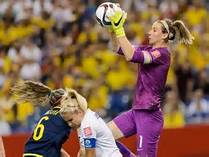
08 Aug Saving Soccer Goalkeepers from Injuries
There is little doubt that soccer goalkeepers are just a bit different than field players.
From legally using hands to their array of jumping and diving abilities, goalkeepers develop unique skill sets .
.
Thus, it shouldn’t be surprising that soccer goalkeeper have different types and causes of injuries
The good news is that soccer goalkeepers statistically don’t get hurt as often as field players.
However, when soccer goalkeepers do get hurt, those injuries can significantly influence individual and team play.
Here is a concise review of common soccer goalkeeper injuries and tips for reducing risks:
Shoulder/forearm/wrist injuries in soccer goalkeepers
Fairly intuitive that diving or stopping balls with hands puts soccer goalkeepers at higher chances of shoulder or arm injuries.
- Fractures to the radius bone: Commonly seen in children or adolescents who have hands driven backwards towards the wrist when trying to make a save on a direct shot.
- Balls shot by adults or use of adult size balls (size 5 versus child-based size 3 or 4 balls) may contribute to increased risk.
§ Risk Reduction Tips: Playing with age-appropriate balls and having adult/older players exercise caution when shooting on younger goalkeepers. There is no solid evidence that use of goalkeeper braces or gloves provide adequate injury reduction.
- Repeated diving and landing on the shoulders can be painful
- Acromioclavicular (AC) joint injury (where collarbone attaches to shoulder girdle) can come from one hard impact
- Glenohumeral joint injury (shoulder “ball and socket joint”) and looseness (aka instability) come from poor technique
- Repetitive throwing of balls can also lead to shoulder pain
*Risk Reduction Tips: Padded shirts may help reduce the impact to the shoulder region. Learn how to dive with a roll that lessens stress to shoulder. Strengthening exercises that focus on muscles around the shoulder girdle (scapula) can help reduce abnormal shoulder motion. Keeping elbows closer to body with diving can also reduce force on the shoulder joint.
Hip/groin injuries in soccer goalkeepers
Unfortunately, soccer players of all positions commonly suffer the perils of hip and groin pain. Soccer goalkeepers are not immune from this malady. However, mechanisms and types of injury do differ somewhat from field players.
- Side-diving can lead to abrasions (cuts) and bruises on the outside of the thigh region. Most of these are a nuisance, though open skin wounds can become infected. Carefully clean any wound and watch closely for redness, warmth or other signs of infection.
- Older, more professional level players may develop bursitis. This is swelling and pain in the bursa (normal fluid-filled cavities between muscles and bones).
§ Risk Reduction Tips: Many soccer goalkeepers used padded shorts for protection. There is little evidence that indicates that such padding reduces injury. No one particular material, size, or brand seems to be superior for reducing injury risk. Using a rolling motion with diving may reduce loading forces on the hip and thigh region.
- Injuries to adductor muscles on the inside of the thigh are more apt to occur in soccer goalkeepers than field players. These are seen especially on the kicking leg. This might be due to the frequent rotational and leaping movements required in goalkeeping. Adductor injuries also might be worsened by repetitive overuse due to multiple long goal kicks or punts..
§ Risk Reduction Tips: Highly recommend the FIFA 11 Soccer Injury Prevention Program. Developed for all players above age 14 to reduce hip/groin and other legs injuries.
Limit the number of longer goal kicks and punts, especially in early season practices with younger players. Allow players to gradually build strength and proper kicking technique. Have field players share in taking goal kicks
Concussion/Head Injuries in soccer goalkeepers
While soccer goalkeepers do not routinely head the ball, jumping or diving increases vulnerability for head injury. Many of these concussions are due to head impact with other players, the ground, or even the goalposts.
- Soccer goalkeepers also have additional risks:
- Close-distance shots directed at them with little time to react or protect the head
- Getting kicked in the head when diving head-first to gain possession of a loose ball.
§ Risk Reduction Tips:
- Using a fist to punch the ball rather than attempt to make a catch in traffic.
- May reduce direct contact with other players or limit chance of feet being taken out from below
- When going up in the air for a catch, raise elbows to protect the head
- Not extending the elbows to impact or injury an opponent
- Avoid going head-first into ball challenges, better to use feet first approach.
- Officials should enforce a reasonable protective halo around diving goalkeepers
- With potential close-range shots, teach goalkeepers to have hands up near face for more immediate protection
· Soft protective helmets might reduce the risk of bruises, cuts, and even skull fractures. They may not be able to limit rotational forces that are thought to contribute the most to concussions. There are also concerns that a player might play more aggressively when wearing a helmet. This might in theory actually increase rather than decrease the risk of head injury.
Knee Injuries in soccer goalkeepers
Rapid cutting/change of direction and off-balance landings on one leg put knees at high risk for Anterior Cruciate Ligament (ACL) tears.
